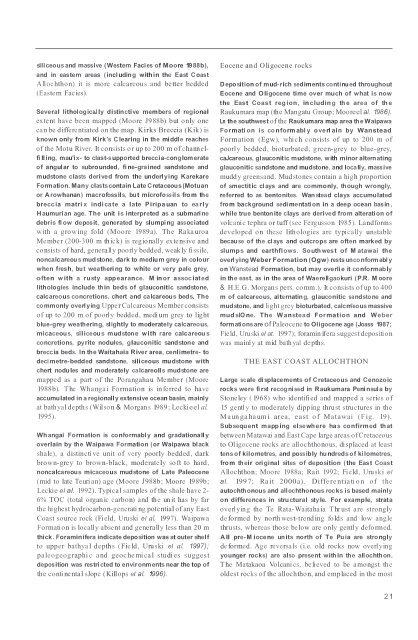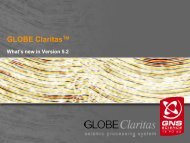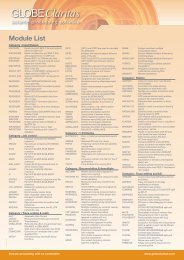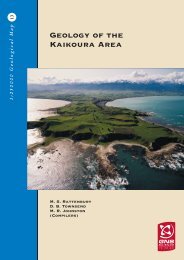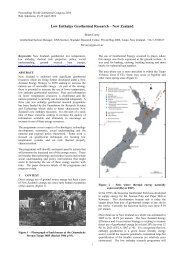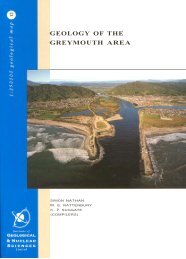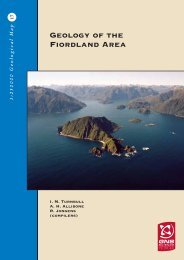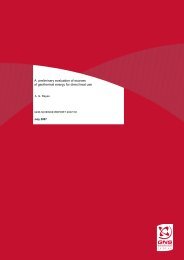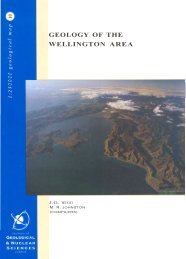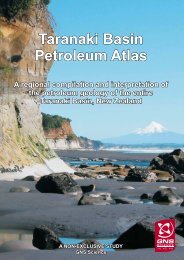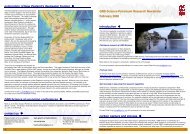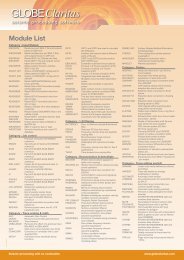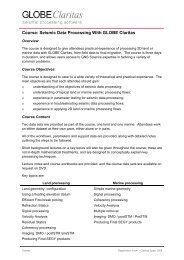GEOLOGY OF THE - GNS Science
GEOLOGY OF THE - GNS Science
GEOLOGY OF THE - GNS Science
Create successful ePaper yourself
Turn your PDF publications into a flip-book with our unique Google optimized e-Paper software.
siliceous and massive (Western Facies of Moore 1988b),and in eastern areas (including with in the East CoastAllochthon) it is more calcareous and better bedded(Eastern Facies).Several lithologicaJ ly distinctive members of regionalextent have been mapped (Moore J988b) but only onecan be differentiated on the map. Kirks Breccia (Kik) isknown only from Kirk's C learing in the middle reachesof the Motu River. It consists or up to 200 m ofchannelfill ing, mau'ix- to clast-s upported breccia-conglomerateof angular to subrounded, fi ne-grained sandstone andmudstone clasts derived from the underl ying KarekareFormation. Many clastscontain Late Cretaceous (Motuanor A rowhanan ) macrofossil s, bu t microfossils fro m thebreccia matri x indicate a late Piripauan to ea rl yHaumurian age. The unit is interpreted as a submari nedebris fl ow deposit, generated by slumpi ng associatedwith a growing fold (Moore 1989a). The Raka uroaMember (200-300 m th ick) is regionally extensive andconsists of hard, genera lly poorl y bedded, weak ly fi ssile,noncalcareou s mudstone, dark to mediu m grey in colourwhen fresh, bu t weatheri ng to white or very pale grey,often w ith a rusty appearance. M in or assoc iatedlithologies include th in beds of glauconitic sandstone,calcareous concretions, chert and calcareous beds. Thecommonly overl ying Upper Calcareous Member consistsof up to 200 m of poorl y bedded, medi um grey to lightblue-grey weathering, slightly to moderately calcareous,micaceou s, siliceou s mudston e with rare calcareou sconcretions, pyrite nodules, glauconitic sandstone andbreccia beds. ln the Waitahaia River area, cenlimetre- todeci metre-bedded sandstone, siliceous mudstone withchert nodu les and moderately calcareolls mudstone aremapped as a part of the Porangahau Member (Moore1988b). The Whangai Formation is in ferred to haveaccumulated in a regionally extensive ocean basin, mainlyat bathyal depths (Wilson & Morgans 1989; Leckieel al.1995).Whangai Formation is conformabl y and gradationall yoverlain by the Waipawa Formation (or Waipawa blackshale), a distincti ve unit of very poorly bedded, darkbrown-grey to brown-black, moderately soft to hard,noncalcareous micaceous mudstone of Late Paleocene(mid to late Teuri an) age (Moore J988b; Moore 1989b;Leckie el al. 1992). Typical samples of the shale have 26% TOC (total organ ic carbon) and the un it has by farthe highest hydrocarbon-generati ng potential of any EastCoast source rock (Field, Uruski el al. 1997). WaipawaFormation is locally absent and generally less than 20 mthick. Foraminifera indicate deposition was at outer shelfto upper bathyal depths (Field, Uruski el al. 1997);paleogeographic and geoche mi ca l studi es suggestdeposition was restri cted to environments near the top ofthe conti nental sJope (Killops el al. 1996).Eocene and Oligocene rocksDeposition of mud-rich sediments continued throughoutEocene and O ligocene time over much of what is nowthe East Coast region, including th e area of th eRaukumara map (the Mangatu Group; Mooreel al. 1986).Ln the southwest of the Raukumara map area th e WaipawaFormati on is co nform abl y overl ain by WansteadFormation (Egw), which consists of up to 200 m ofpoorly bedded, bioturbated, green-grey to blue-grey,caJcareous, glauconitic mudstone, w ith minor alternatingglauconitic sandstone and mudstone, and locally, massivemuddy greensand . Mudstones contain a high proportionof smectitic cl ays and are commonly, th ough wrongly,referred to as bentonites. Wan stead clays accumulatedfro m background sedi mentati on in a deep ocean basin ,while true benton ite clays are derived from alterati on ofvolcanic tephra or tuff (see Fergusson 1985). Landformsdeveloped on these lithologies are typically unstablebecau se of the cl ays and outcrops are often marked byslumps and earthflows. South wes t of M atawai theoverl ying Weber Formation (Ogw) rests unconform abl yon Wanstead Formation, but may overli e it conformablyin th e east, as in the area of Waerellgaokuri (P.R. M oore& H.E.G. Morgans pers. comm.). It consists of up to 400m of calcareous, al ternatin g, glauconitic sandstone andmudstone, and light grey bioturbated, calcm'eous massivemudslO ne. The W anstead Formation and Weberformationsare ofPaleocene to Oligocene age (Joass 1987;Field, Uruski el at. 1997); foramin ifera suggest depositionwas mainl y at mid bath yal depths.<strong>THE</strong> EAST COAST ALLOCHTHONLarge scale displacements of Cretaceous and Cenozoicrocks were fi rst recogni sed in Raukumara Peni nsula byStoneley ( 1968) who identified and mapped a series of15 gentl y to moderately dipping thrust structures in theM a un gaha um i area, east o f Matawai (Fig. 19).Subsequent mapp ing else wh ere has confirmed th atbetween Matawai and East Cape large areas ofCretaceousto Ol igocene rocks are allochthonous, displaced at leasttens of kilometres, and possibly hu ndreds of kilometres,fro m th eir ori ginal sites of deposition (the Eas t CoastAllochthon; Moore 1988a; Rait 1992; Field, Uruski elal. 1997; Rait 2000a). Diffe re ntia ti o n of theautochth onous and allochthonous roc ks is based mainlyon differences in stru ctural sty le. For example, strataoverl ying the Te Rata-Waitahaia Thr ust are stronglyde formed by north west-trend ing fo lds and low anglethrusts, whereas those below are only gently deformed.A ll pre-M iocene un its north of Te Pu ia are stronglyde formed. Age reversals (i.e. old rocks now overl yingyounger rocks) are also present with in the allochthon.The Matakaoa Volcani cs, be lieved to be amongst theoldest rocks of the allochthon, and emplaced in the most2 1


